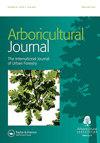Re: CAVAT (Capital Asset Value for Amenity Trees): valuing amenity trees as public assets Arboricultural Journal Volume 40(2) pages 67–91
Q3 Agricultural and Biological Sciences
引用次数: 0
Abstract
Dear Editor I write not to provide a full commentary on the above paper but clarify a number of issues when it comes to “compensation”. Valuation is a practice that uses familiar words in precise, defined ways. Without definitions, discussion of valuation practices may lead to misunderstanding and possible confusion. Valuation best practice helps make valuation estimates consistent, objective and transparent. However, an estimate of value is the subjective opinion of the valuer! Use of best practice builds confidence in valuations so they can be understood and respected. The main body of the CAVAT paper mentions the word “compensation” a mere 23 times with additional uses in the paper’s keywords, abstracts, highlights and titles. No definition of the term is provided. Furthermore, the paper introduces the terms “compensation replacement value”, “adequate compensation”, “compensation value”, “appropriate compensation”, “appropriate level of compensation” and “financial compensation” without explanation. Whilst conceptually all readers may be aware of the principle of compensation, with valuation the devil is in the detail. It would have been interesting to read how the authors decided that any particular value was, in their opinion, “adequate” and/or “appropriate”. Valuation produces no “right” answers, merely judgment and opinion with inevitable room for disagreement and dispute. It only takes a little experience with using CAVAT to find that the CAVAT valuation formula inevitably produces much larger estimates of value for large trees than any other valuation system. It is this feature of CAVAT that underpins the potential for disputes or at least disagreement. In my view, the paper appears to confound two different valuation problems:回复:CAVAT(美化树木的资本资产价值):将美化树木作为公共资产进行评估。《树木学杂志》第40卷(2)页67-91
亲爱的编辑:我写这封信不是为了对上述文章提供完整的评论,而是为了澄清一些关于“薪酬”的问题。估值是一种以精确、明确的方式使用熟悉词汇的实践。如果没有定义,对估价实践的讨论可能会导致误解和混淆。估值最佳实践有助于使估值评估保持一致、客观和透明。然而,价值估计是估价者的主观意见!使用最佳实践可以建立对估值的信心,从而使它们能够被理解和尊重。CAVAT论文的主体仅仅23次提到了“补偿”一词,在论文的关键词、摘要、重点介绍和标题中也有使用。没有提供该术语的定义。此外,本文还引入了“补偿重置价值”、“充分补偿”、“补偿价值”、“适当补偿”、“适当补偿水平”和“经济补偿”等术语,但未作解释。虽然从概念上讲,所有读者可能都知道补偿原则,但在估值方面,细节决定成败。如果能读到作者是如何决定在他们看来任何特定的价值是“适当的”和/或“适当的”,那将是一件有趣的事情。估值不会产生“正确”的答案,仅仅是判断和意见,不可避免地存在分歧和争议的空间。只需要一点点使用CAVAT的经验就可以发现,CAVAT估值公式不可避免地会产生比任何其他估值系统大得多的大树价值估计值。正是CAVAT的这一特点,支持了纠纷或至少是分歧的可能性。在我看来,这篇论文似乎混淆了两个不同的估值问题:
本文章由计算机程序翻译,如有差异,请以英文原文为准。
求助全文
约1分钟内获得全文
求助全文
来源期刊

Arboricultural Journal
Agricultural and Biological Sciences-Agronomy and Crop Science
CiteScore
2.40
自引率
0.00%
发文量
28
期刊介绍:
The Arboricultural Journal is published and issued free to members* of the Arboricultural Association. It contains valuable technical, research and scientific information about all aspects of arboriculture.
 求助内容:
求助内容: 应助结果提醒方式:
应助结果提醒方式:


